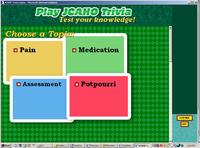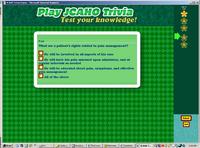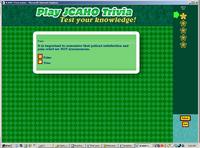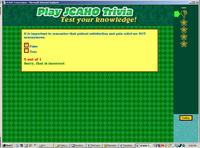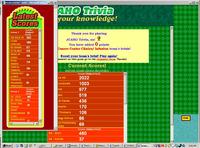I. JCAHO Trivia - Background, objectives, and game play
Jump to Part III - Building the Game.=>
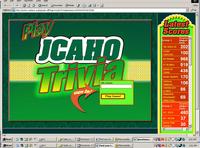
(click to enlarge image)
In June, as a small part of a larger hospital staff training project, I built an educational online game for the nursing department. There were several requirements that helped determine the shape of the final result.
Synchronous game play vs. Asynchronous: When considering what kind of game might be best for our purposes, we first considered one based on Jeopardy, since that format is so popular.
However, Jeopardy is not an asynchronous system. In other words, each Jeopardy round is a timed competition against several other players, all of whom must be playing simultaneously or "synchronously" as the elearning people call it.
Ads by Google
Posted by ellen at August 02, 2004 10:42 AM
Our players would definitely be playing asynchronously. They work in shifts all over the clock, and are lucky to grab a few minutes out of their busy schedules for any type of diversion, including this game. So game length had to be as flexible as possible.
Computer "Judging": Another issue with Jeopardy is that Jeopardy-style questions are of the "fill-in-the-blanks" variety, where slight variations of the answer may be correct. For example the answer to "The big apple" might be "what is New York?" or "what is New York City?" or even "what is NYC?" Such questions are difficult to program a computer to grade correctly because of all the possible right answers, each of which has to be anticipated and entered. Because of the huge volume of questions, we needed a much easier question structure, such as multiple choice.
Ease of loading new content: Even if using multiple choice, I did not want to edit and set up hundreds or perhaps thousands of questions myself! I needed a simple text-based content format that could be provided to me by the question authors, ready to import into the game.
People must WANT to compete! The one thing Jeopardy DOES have that we wanted to emulate was an intensely competitive game play. That appealed to everyone involved with the project, so we wanted to bring that to our own game somehow. A real-time scoreboard, showing live scores before and after every round of play seemed like a good way to keep people's interest up. If they could see their own contribution to the team's efforts, it would provide some very positive feedback.
No "Down Side" to the game: Another key element must be that there be no "down-side" to the game - no negatives. Players must not be penalized for wrong answers. We hoped to encourage everyone to play, even if only for a few minutes. We didn't want them to feel they had to prepare themselves, or worry if they got a few wrong - there should be no barrier to just sitting down and playing.
Since developing a game engine from scratch would be very expensive and time-consuming, I thought about what kind of game could be made using readily available software, including Questionmark Perception which we use for quizzes and tests. I decided that if we used Perception, it would be simpler to make this a Trivial Pursuit style game. I mocked up some screens, and "JCAHO Trivia" was approved for production. One thing was made clear to me, the game had to pass the "fun" test! It must not look like a regular quiz or no one would want to play! It turned out that we finally came up was so successful, that I'm posting a complete description since the same game could be modified for many teaching situations.
How the game is played: The nursing staff was broken up into 5 big groups, each of which created their own teams, which were composed of one or more nursing units. The teams within each group compete with each other. The one with the highest score at the end of the month wins. So there are 5 prizes awarded every month.
Players click on their team's link on the entry screen:
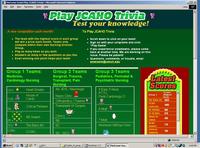
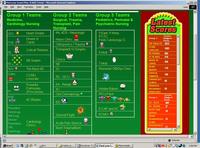
then enter their username on the login page:

(click to enlarge image)
On choosing a topic, they get a bank of five questions at a time, randomly selected from about 100 in each topic. Clicking on the daisies brings up the next question in turn.
Players can answer as few or as many as they like of the five questions. As questions are answered, their "daisies" fill in.
After finishing each bank of questions, the player gets a topic score and feedback on each question...
and then are returned to the "Choose a Topic" screen where they can choose to repeat the topic (with new questions) or choose another topic.
At this point they can also quit playing and get the final total score. As soon as their final score displays on screen, it also gets added to the red scoreboard which re-appears on the last page of the game.
A single round of the game lasts one month, at which time the winning team in each section is given a prize to share amongst themselves (a party or trophy) and the game starts over with new topics and new questions. New questions are also added in the middle of each month to keep things fresh.
Ads by Google
